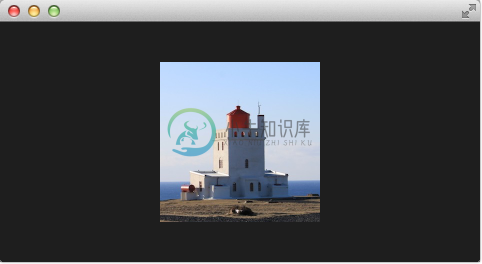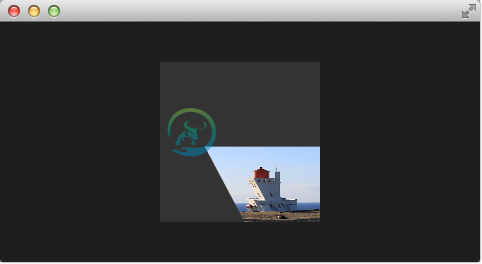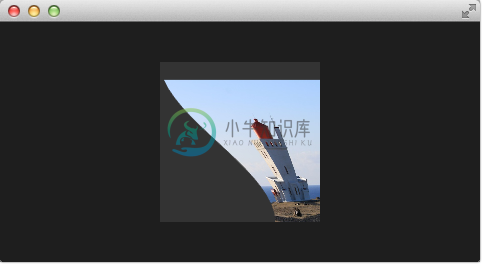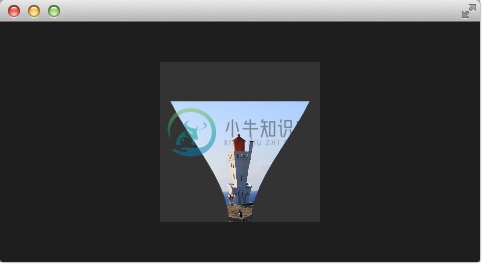9.5 顶点着色器(Vertex Shader)
顶点着色器用来操作ShaderEffect提供的顶点。正常情况下,ShaderEffect有4个顶点(左上top-left,右上top-right,左下bottom-left,右下bottom-right)。每个顶点使用vec4类型记录。为了实现顶点着色器的可视化,我们将编写一个吸收的效果。这个效果通常被用来让一个矩形窗口消失为一个点。

配置场景(Setting up the scene)
首先我们再一次配置场景。
import QtQuick 2.0
Rectangle {
width: 480; height: 240
color: '#1e1e1e'
Image {
id: sourceImage
width: 160; height: width
source: "assets/lighthouse.jpg"
visible: false
}
Rectangle {
width: 160; height: width
anchors.centerIn: parent
color: '#333333'
}
ShaderEffect {
id: genieEffect
width: 160; height: width
anchors.centerIn: parent
property variant source: sourceImage
property bool minimized: false
MouseArea {
anchors.fill: parent
onClicked: genieEffect.minimized = !genieEffect.minimized
}
}
}
这个场景使用了一个黑色背景,并且提供了一个使用图片作为资源纹理的ShaderEffect。使用image元素的原图片是不可见的,只是给我们的吸收效果提供资源。此外我们在ShaderEffect的位置添加了一个同样大小的黑色矩形框,这样我们可以更加明确的知道我们需要点击哪里来重置效果。

点击图片将会触发效果,MouseArea覆盖了ShaderEffect。在onClicked操作中,我们绑定了自定义的布尔变量属性minimized。我们稍后使用这个属性来触发效果。
最小化与正常化(Minimize and normalize)
在我们配置好场景后,我们定义一个real类型的属性,叫做minimize,这个属性包含了我们当前最小化的值。这个值在0.0到1.0之间,由一个连续的动画来控制它。
property real minimize: 0.0
SequentialAnimation on minimize {
id: animMinimize
running: genieEffect.minimized
PauseAnimation { duration: 300 }
NumberAnimation { to: 1; duration: 700; easing.type: Easing.InOutSine }
PauseAnimation { duration: 1000 }
}
SequentialAnimation on minimize {
id: animNormalize
running: !genieEffect.minimized
NumberAnimation { to: 0; duration: 700; easing.type: Easing.InOutSine }
PauseAnimation { duration: 1300 }
}
这个动画绑定了由minimized属性触发。现在我们已经配置好我们的环境,最后让我们看看顶点着色器的代码。
vertexShader: "
uniform highp mat4 qt_Matrix;
attribute highp vec4 qt_Vertex;
attribute highp vec2 qt_MultiTexCoord0;
varying highp vec2 qt_TexCoord0;
uniform highp float minimize;
uniform highp float width;
uniform highp float height;
void main() {
qt_TexCoord0 = qt_MultiTexCoord0;
highp vec4 pos = qt_Vertex;
pos.y = mix(qt_Vertex.y, height, minimize);
pos.x = mix(qt_Vertex.x, width, minimize);
gl_Position = qt_Matrix * pos;
}"
顶点着色器被每个顶点调用,在我们这个例子中,一共调用了四次。默认下提供qt已定义的参数,如qt_Matrix,qt_Vertex,qt_MultiTexCoord0,qt_TexCoord0。我们在之前已经讨论过这些变量。此外我们从ShaderEffect中链接minimize,width与height的值到我们的顶点着色器代码中。在main函数中,我们将当前纹理值保存在qt_TexCoord()中,让它在片段着色器中可用。现在我们拷贝当前位置,并修改顶点的x,y的位置。
highp vec4 pos = qt_Vertex;
pos.y = mix(qt_Vertex.y, height, minimize);
pos.x = mix(qt_Vertex.x, width, minimize);
mix(...)函数提供了一种在两个参数之间(0.0到1.0)的线性插值的算法。在我们的例子中,在当前y值与高度值之间基于minimize的值插值获得y值,x的值获取类似。记住minimize的值是由我们的连续动画控制,并且在0.0到1.0之间(反之亦然)。

这个结果的效果不是真正吸收效果,但是已经能朝着这个目标完成了一大步。
基础弯曲(Primitive Bending)
我们已经完成了最小化我们的坐标。现在我们想要修改一下对x值的操作,让它依赖当前的y值。这个改变很简单。y值计算在前。x值的插值基于当前顶点的y坐标。
highp float t = pos.y / height;
pos.x = mix(qt_Vertex.x, width, t * minimize);
这个结果造成当y值比较大时,x的位置更靠近width的值。也就是说上面2个顶点根本不受影响,它们的y值始终为0,下面两个顶点的x坐标值更靠近width的值,它们最后转向同一个x值。

import QtQuick 2.0
Rectangle {
width: 480; height: 240
color: '#1e1e1e'
Image {
id: sourceImage
width: 160; height: width
source: "assets/lighthouse.jpg"
visible: false
}
Rectangle {
width: 160; height: width
anchors.centerIn: parent
color: '#333333'
}
ShaderEffect {
id: genieEffect
width: 160; height: width
anchors.centerIn: parent
property variant source: sourceImage
property real minimize: 0.0
property bool minimized: false
SequentialAnimation on minimize {
id: animMinimize
running: genieEffect.minimized
PauseAnimation { duration: 300 }
NumberAnimation { to: 1; duration: 700; easing.type: Easing.InOutSine }
PauseAnimation { duration: 1000 }
}
SequentialAnimation on minimize {
id: animNormalize
running: !genieEffect.minimized
NumberAnimation { to: 0; duration: 700; easing.type: Easing.InOutSine }
PauseAnimation { duration: 1300 }
}
vertexShader: "
uniform highp mat4 qt_Matrix;
uniform highp float minimize;
uniform highp float height;
uniform highp float width;
attribute highp vec4 qt_Vertex;
attribute highp vec2 qt_MultiTexCoord0;
varying highp vec2 qt_TexCoord0;
void main() {
qt_TexCoord0 = qt_MultiTexCoord0;
// M1>>
highp vec4 pos = qt_Vertex;
pos.y = mix(qt_Vertex.y, height, minimize);
highp float t = pos.y / height;
pos.x = mix(qt_Vertex.x, width, t * minimize);
gl_Position = qt_Matrix * pos;
更好的弯曲(Better Bending)
现在简单的弯曲并不能真正的满足我们的要求,我们将添加几个部件来提升它的效果。首先我们增加动画,支持一个自定义的弯曲属性。这是非常必要的,由于弯曲立即发生,y值的最小化需要被推迟。两个动画在同一持续时间计算总和(300+700+100与700+1300)。
property real bend: 0.0
property bool minimized: false
// change to parallel animation
ParallelAnimation {
id: animMinimize
running: genieEffect.minimized
SequentialAnimation {
PauseAnimation { duration: 300 }
NumberAnimation {
target: genieEffect; property: 'minimize';
to: 1; duration: 700;
easing.type: Easing.InOutSine
}
PauseAnimation { duration: 1000 }
}
// adding bend animation
SequentialAnimation {
NumberAnimation {
target: genieEffect; property: 'bend'
to: 1; duration: 700;
easing.type: Easing.InOutSine }
PauseAnimation { duration: 1300 }
}
}
此外,为了使弯曲更加平滑,不再使用y值影响x值的弯曲函数,pos.x现在依赖新的弯曲属性动画:
highp float t = pos.y / height;
t = (3.0 - 2.0 * t) * t * t;
pos.x = mix(qt_Vertex.x, width, t * bend);
弯曲从0.0平滑开始,逐渐加快,在1.0时逐渐平滑。下面是这个函数在指定范围内的曲线图。对于我们,只需要关注0到1的区间。

想要获得最大化的视觉改变,需要增加我们的顶点数量。可以使用网眼(mesh)来增加顶点:
mesh: GridMesh { resolution: Qt.size(16, 16) }
现在ShaderEffect被分布为16x16顶点的网格,替换了之前2x2的顶点。这样顶点之间的插值将会看起来更加平滑。

你可以看见曲线的变化,在最后让弯曲变得非常平滑。这让弯曲有了更加强大的效果。
侧面收缩(Choosing Sides)
最后一个增强,我们希望能够收缩边界。边界朝着吸收的点消失。直到现在它总是在朝着width值的点消失。添加一个边界属性,我们能够修改这个点在0到width之间。
ShaderEffect {
...
property real side: 0.5
vertexShader: "
...
uniform highp float side;
...
pos.x = mix(qt_Vertex.x, side * width, t * bend);
"
}

包装(Packing)
最后将我们的效果包装起来。将我们吸收效果的代码提取到一个叫做GenieEffect的自定义组件中。它使用ShaderEffect作为根元素。移除掉MouseArea,这不应该放在组件中。绑定minimized属性来触发效果。
import QtQuick 2.0
ShaderEffect {
id: genieEffect
width: 160; height: width
anchors.centerIn: parent
property variant source
mesh: GridMesh { resolution: Qt.size(10, 10) }
property real minimize: 0.0
property real bend: 0.0
property bool minimized: false
property real side: 1.0
ParallelAnimation {
id: animMinimize
running: genieEffect.minimized
SequentialAnimation {
PauseAnimation { duration: 300 }
NumberAnimation {
target: genieEffect; property: 'minimize';
to: 1; duration: 700;
easing.type: Easing.InOutSine
}
PauseAnimation { duration: 1000 }
}
SequentialAnimation {
NumberAnimation {
target: genieEffect; property: 'bend'
to: 1; duration: 700;
easing.type: Easing.InOutSine }
PauseAnimation { duration: 1300 }
}
}
ParallelAnimation {
id: animNormalize
running: !genieEffect.minimized
SequentialAnimation {
NumberAnimation {
target: genieEffect; property: 'minimize';
to: 0; duration: 700;
easing.type: Easing.InOutSine
}
PauseAnimation { duration: 1300 }
}
SequentialAnimation {
PauseAnimation { duration: 300 }
NumberAnimation {
target: genieEffect; property: 'bend'
to: 0; duration: 700;
easing.type: Easing.InOutSine }
PauseAnimation { duration: 1000 }
}
}
vertexShader: "
uniform highp mat4 qt_Matrix;
attribute highp vec4 qt_Vertex;
attribute highp vec2 qt_MultiTexCoord0;
uniform highp float height;
uniform highp float width;
uniform highp float minimize;
uniform highp float bend;
uniform highp float side;
varying highp vec2 qt_TexCoord0;
void main() {
qt_TexCoord0 = qt_MultiTexCoord0;
highp vec4 pos = qt_Vertex;
pos.y = mix(qt_Vertex.y, height, minimize);
highp float t = pos.y / height;
t = (3.0 - 2.0 * t) * t * t;
pos.x = mix(qt_Vertex.x, side * width, t * bend);
gl_Position = qt_Matrix * pos;
}"
}
你现在可以像这样简单的使用这个效果:
import QtQuick 2.0
Rectangle {
width: 480; height: 240
color: '#1e1e1e'
GenieEffect {
source: Image { source: 'assets/lighthouse.jpg' }
MouseArea {
anchors.fill: parent
onClicked: parent.minimized = !parent.minimized
}
}
}
我们简化了代码,移除了背景矩形框,直接使用图片完成效果,替换了在一个单独的图像元素中加载它。

